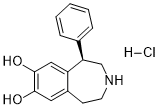This product is for research use only, not for human use. We do not sell to patients.

| Size | Price | Stock |
|---|---|---|
| 25mg | $199 | To Be Confirmed |
| 50mg | $289 | To Be Confirmed |
| 100mg | $450 | To Be Confirmed |
| 250mg | $779 | To Be Confirmed |
| 500mg | $1070 | To Be Confirmed |
Cat #: V4042 CAS #: 81702-42-3 Purity ≥ 98%
Description: R(+)-SKF-38393A (the R-isomer of SKF3839A) is a novel potent and selective dopamine D1 receptor agonist with IC50 of 110 nM, the (+)-enantiomer is the active isomer. Agonism of the D1DR by SKF 38393 is correlated to induced desynchronization of electroencephalographic activity in rats. SKF 38393 also demonstrated agonism of the serotonin SR-2C (5-HT1C receptor). SKF 38393 HCl is an activator of D5DR. In locally anesthetized, artificially respired, gallamine-treated rats, i.v. administration of SKF 38393 significantly altered dopamine cell activity. In these rats, firing rate increases and decreases were also observed.
Publications Citing InvivoChem Products
Product Promise

- Physicochemical and Storage Information
- Protocol
- Related Biological Data
- Stock Solution Preparation
- Quality Control Documentation
| Molecular Weight (MW) | 291.77 |
|---|---|
| Molecular Formula | C16H17NO2 . HCl |
| CAS No. | 81702-42-3 |
| Storage | -20℃ for 3 years in powder form |
| -80℃ for 2 years in solvent | |
| Solubility In Vitro | DMSO: 58 mg/mL (198.8 mM) |
| Water: <1 mg/mL | |
| Ethanol: 6 mg/mL (20.6 mM) | |
| SMILES Code | OC1=C(O)C=C2C(C3=CC=CC=C3)CNCCC2=C1.[H]Cl |
| Synonyms | SKF-38393; SKF 38393; SKF38393; SKF-38,393; SKF 38,393; SKF38,393; SKF-38393 HCl; SKF-38393 hydrochloride; SKF-38393A; SKF 38393A; SKF38393A; R(+)-SKF-38393A; R(+) SKF 38393A; R(+)SKF38393A; R-SKF-38393A; R SKF 38393A; RSKF38393A; |
| Protocol | In Vitro | In vitro activity: SKF38393 (50-100 μM) induces long-lasting synaptic potentiation in a protein synthesis-dependent manner. In rat prefrontal cortical neurons in vitro, SKF 38393 mimicks the effects of DA on I(NaP), and modulates a persistent sodium current. In the auditory cortex, SKF38393 affects long-term memory formation and consolidation by activating the downstream effectors adenylyl cyclase and phospholipase C-prominent proteomic alterations. Kinase Assay: SKF 38393 hydrochloride is a D1 agonist with IC50 of 110 nM. |
|---|---|---|
| In Vivo | SKF 38393(6 mg/kg, i.p.) prevents the scopolamine-induced impairment of performance of a T-maze working memory task. In adult male NMRI mice, SKF38393 (1 μg/mouse) impaires context-dependent fear learning. | |
| Animal model | Male Wistar rats |
| Solvent volume to be added | Mass (the weight of a compound) | |||
|---|---|---|---|---|
| Mother liquor concentration | 1mg | 5mg | 10mg | 20mg |
| 1mM | 3.4274 mL | 17.1368 mL | 34.2736 mL | 68.5471 mL |
| 5mM | 0.6855 mL | 3.4274 mL | 6.8547 mL | 13.7094 mL |
| 10mM | 0.3427 mL | 1.7137 mL | 3.4274 mL | 6.8547 mL |
| 20mM | 0.1714 mL | 0.8568 mL | 1.7137 mL | 3.4274 mL |
This equation is commonly abbreviated as: C1 V1 = C2 V2
- (1) Please be sure that the solution is clear before the addition of next solvent. Dissolution methods like vortex, ultrasound or warming and heat may be used to aid dissolving.
- (2) Be sure to add the solvent(s) in order.







































